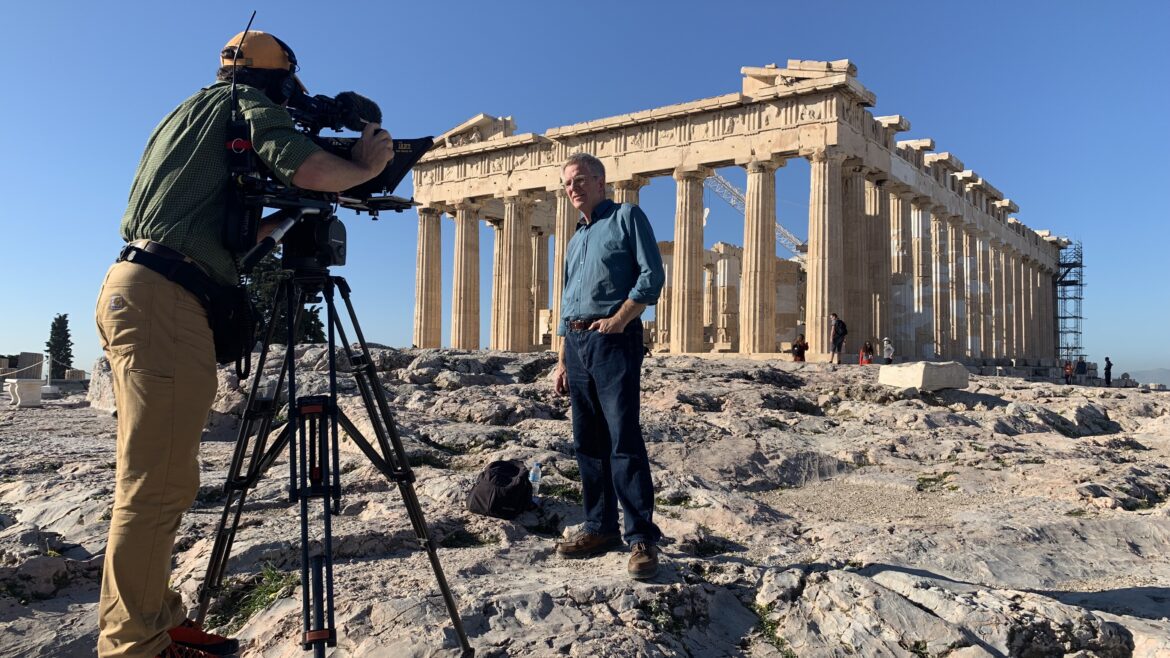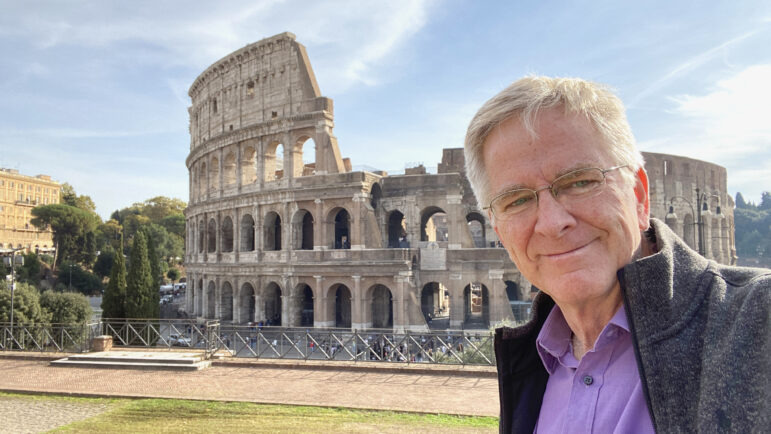Rick Steves series premiering this fall takes viewers through thousands of years of European art

Rick Steves' Europe
Rick Steves' Art of Europe film shoot at the Parthenon in Athens.
Rick Steves’ Art of Europe is the fulfillment of a longstanding dream for public media’s prolific travel show host.
In the six-part limited series premiering on public television this October, Steves travels to the Vatican to view Michelangelo’s masterwork, climbs into prehistoric tombs in the Scottish isles and tours ornate French palaces. The six episodes cover the evolution and achievements of European art chronologically, starting with the Stone Age and Ancient Greece and moving on to programs devoted to Ancient Rome, the Middle Ages, the Renaissance, the Baroque period and the Modern Age.
“We’ve been collecting footage for this for 20 years,” Steves said in an interview. “I just had to get to a critical mass of collecting all this great art in our archives. Two years ago, I thought, ‘Now it’s time to weave it all together.’”
Steves, who tours the world for his media and travel business but lives in Edmonds, Wash., was grounded by coronavirus lockdowns during 2020 and most of 2021, but he kept busy. He returned to Europe late last year. His travel company has resumed offering tours to Europe. And now he’s wrapping up production for Rick Steves’ Art of Europe, which combines footage that’s been collected over the past 20 years along with a plethora of new material.

“Ninety percent of the on-cameras have been since the pandemic,” Steves said, referring to scenes when he’s addressing viewers. “I’ve been able to go with my crew to the greatest cities for European art,” he said, naming Florence, Rome, Athens, London, Paris, Belgium, Madrid and Vienna — along with megalithic sites in England — as his favorites.
Steves said Art of Europe is partly inspired by Civilisation, a renowned 1969 13-part BBC television program presented by historian Kenneth Clark, who died in 1983. “I just loved that show,” he said, though he described it as “very old-school” and “ethnocentric.”
Steves wanted his art series to be “refreshing” while still giving viewers plenty of information to sift through. Viewers who haven’t studied art will be able to “get a grasp on what the Renaissance is before their eyes glaze over,” he said. His specialty is creating TV shows that are “meaningful and accessible” for “people who are smart and curious but don’t know much about art or history.”
Steves is working with several scholars to vet information presented in the series, tweaking things down to the wire. As his team trims the shows to broadcast length, some information, mainly “historical tangents,” will be left on the cutting room floor. “A lot of times, less is more if it’s well-written,” Steves said.
American Public Television is distributing the series nationally in a deal that expands Steves’ relationship with the Boston-based distributor. Oregon Public Broadcasting has presented the bulk of Steves’ programs on public TV, but has stepped back from the role of presenting station. Going forward, APT will handle the Rick Steves’ Europe programming catalog including international licensing. Steves doesn’t expect these changes to significantly affect his programs but said he’s happy that he and APT have forged a larger partnership.
While Art of Europe premieres this fall as a six-hour package for prime time broadcasts, Steves estimated that each episode will be reformatted next year to work as a standalone program. That will give television programmers flexibility to schedule the individual shows without committing to the entire six-hour series.
“It’s quite a dedication of scheduling time for stations to commit to six hours and maybe they only have an hour to fill,” Steves said.
He was most nervous about the first hour of the series because he didn’t know if the topic of prehistoric art would connect with viewers. But after viewing the rough cut, Steves said he’s “entranced” by the first hour in particular. He’s excited to see how viewers react to the series.
“As a tour guide, a teacher, a TV producer and somebody whose mission is to celebrate and appreciate art, this series is something I’ve waited to do all my career,” he said. “We get to shoot this stuff and we get to bring it home and share it.”





